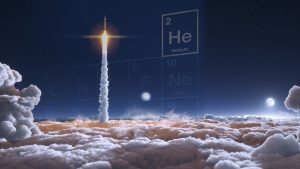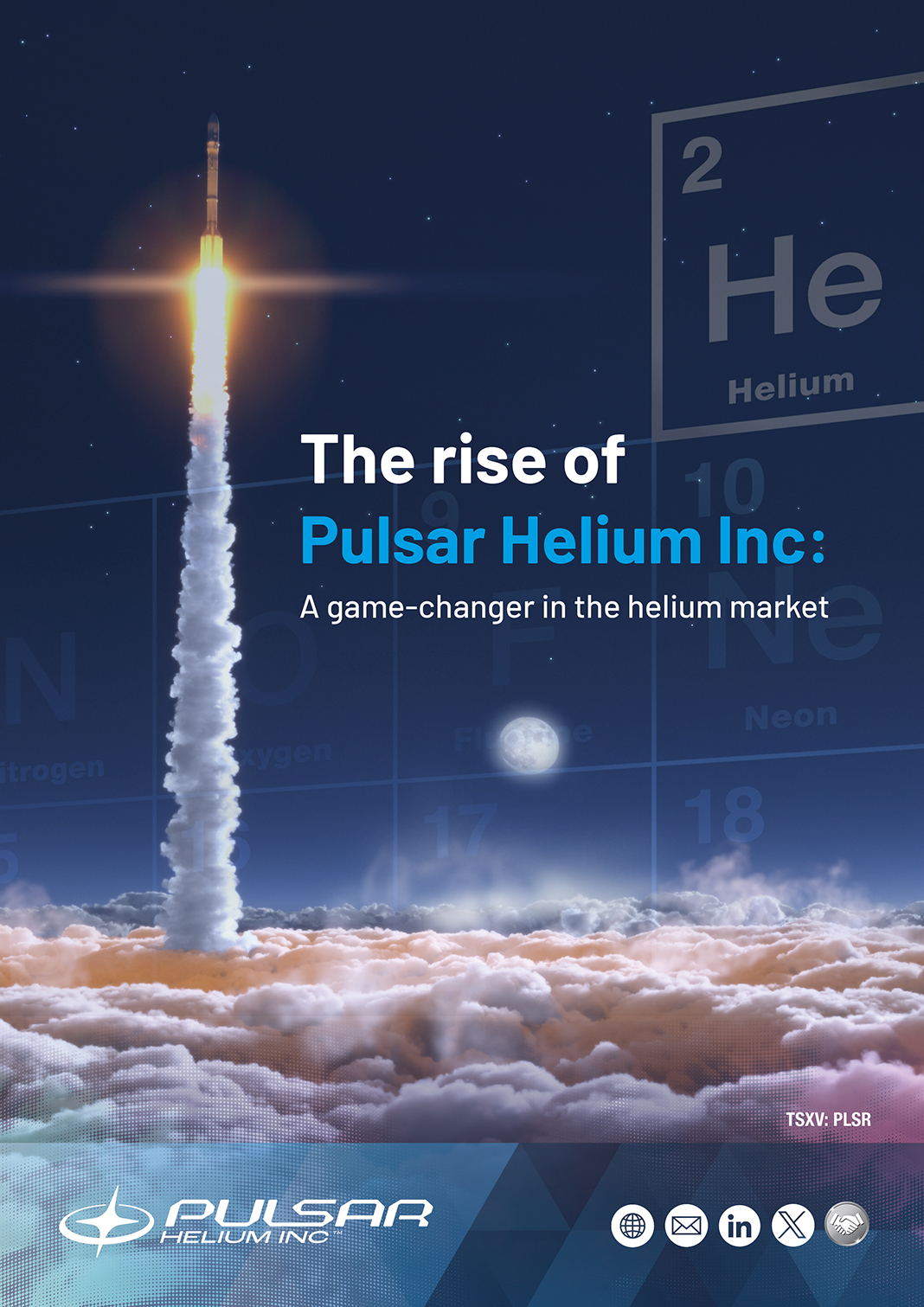In Pulsar Helium’s new eBook, the company explores how it is advancing its helium projects to the point of potential production to ensure the world can successfully secure a supply of primary helium.
Pulsar Helium Inc. is committed to advancing its helium projects to the point of potential production, to ensure that the world can successfully secure a supply of primary helium.
Helium is a critically important element with unique properties and applications which make it indispensable and essential to everyday life.
From the construction of our cities to the precise diagnosis of medical conditions, to the frontiers of scientific exploration, to the production of the very latest consumer technology, helium touches our lives in ways we often overlook.
Pulsar Helium Inc. is committed to advancing its helium projects to the point of potential production, to ensure that the world can successfully secure a supply of primary helium. Pulsar listed on the TSX Venture on the 15th of August 2023, trading under the ticker PLSR.
Pulsar’s flagship is the Topaz Project, located in Minnesota, US. Topaz has been drilled and flowed 10.5% helium, one of the highest-concentration discoveries globally. Pulsar is now fast-tracking activities there, with its much-anticipated appraisal well scheduled for Q4 2023.
The well will be drilled nearby to the discovery hole and all applicable down-hole testing will be conducted.
Pulsar is the first mover in Minnesota and has the technical and corporate experience required to be the much-needed game-changer in the helium market.
Meanwhile, Pulsar’s Tunu Project in Greenland is at an earlier stage, but with the requisite geological features sought after for a helium system. The land position is large, close to 700,000 acres of exclusive mineral rights. Like Topaz, Pulsar is the first mover in Greenland for helium exploration.
In this eBook, Pulsar outlines how it is playing an essential role in sourcing helium and provides a detailed insight into how helium applications can be used in our everyday lives.

Introduction to helium and its uses
Helium is a colourless, inert, and odourless noble gas, that is non-toxic and the second-lightest element on the periodic table. Helium is scarce on Earth, yet abundant in the rest of the Universe. As helium is so light, it readily escapes Earth’s atmosphere.
Concentrations of helium on Earth are located in geological reservoirs deep within the ground, with the gas trapped by an impermeable cap rock. Other industrial gases, including oxygen, argon, and nitrogen are comparatively easy to come by as they can be processed from the atmosphere that we breathe via an air separation unit. Helium is not as abundant or as readily accessible therefore making it a strategic commodity in the industrial gas industry, where a reliable supply of helium is paramount.
The majority of helium is utilised by the tech industry, with party balloons being approximately 2% of the market share and a frivolous waste of a critical commodity. Helium is the unsung hero of the technical world, essential in the manufacturing of components for everyday items, including cell phones, televisions, electric vehicles, and even the internet.
Some of the major uses of helium are as follows:
Semiconductors
Due to their computing capability, semiconductors are crucial components in the automotive industry, particularly in modern electric vehicles. The vehicle’s ‘brain’ enables all electronic processes, such as power and drive management, infotainment systems, autonomous driving, and even headlamps. Typically made of silicon, semiconductors conduct electricity better than insulators and are found in computer chips and processors.
During the semiconductor manufacturing process, chemical reactions are usually gas or liquid-based. Using inert gas, like helium, around the silicon helps prevent unwanted reactions, as helium does not react with other elements.
Additionally, helium has a high thermal conductivity, which aids in heat transfer, allowing for effective temperature control during the manufacturing process and making it possible to miniaturise semiconductors.
Aerospace
In aerospace, liquid helium is used as a pressure agent for cryogenic fuel tanks in space rockets. As the rocket burns fuel (liquid oxygen or hydrogen), the fuel tank is purged with liquid helium to maintain pressure. When you see a rocket on the launch pad with gas emanating from its side, it is likely that this is helium boiling at -268.9˚C.

Fibre optic cables
The manufacturing of fibre optic cables utilises an all-helium environment to prevent air bubbles from being trapped in the optical fibres. Computer hard drives are also utilising a helium atmosphere to allow the disk to spin more freely and create less heat.
Leak detection
Helium is commonly used in leak detection tests during battery cell, module, and pack production processes, as it is non-toxic, non-flammable, and does not react with other substances. Introducing helium into the system and monitoring its presence outside the system enables technicians to detect even the most minor leaks quickly and accurately.
MRI scanners
In the USA alone, there are approximately 12,000 Magnetic Resonance Imaging (MRI) scanners, with each unit utilising 1,700 litres of liquid helium on average. If all were to be filled, this figure would account for approximately 10% of annual helium production.

Not to mention the regular top-up that is required due to helium’s small atomic size (therefore leakage). Helium’s importance to the medical industry is especially critical as MRI uptake is forecast to grow at 5.5% per annum in a period of prolonged supply shortage.
Welding
Another application of helium is in the automotive industry. Helium is critical in welding certain types of metals, particularly aluminium. Welding combines different parts of a car, such as the body panels and chassis.
Helium is used as a shielding gas during welding to protect welds from contamination by surrounding air, which can cause oxidation that weakens the weld. The use of helium in welding produces high-quality, durable welds that are crucial for vehicle safety in the automotive industry.
Laser cutting
Helium is also an excellent shielding gas in laser cutting, which is necessary for fabricating precision components. A high-energy laser beam is used to melt or vaporise the cut material, and the shielding gas is used to blow away the molten or vapourised material, leaving a clean cut.
Helium’s high thermal conductivity helps to remove heat from the cutting area, preventing materials from melting or warping. Additionally, helium is inert, preventing material contamination and reducing the risk of oxidation or corrosion, which is particularly important when cutting sensitive materials like stainless steel or aluminium. Helium’s lightness also allows it to be easily blown away from the cutting area, preventing it from interfering with the laser beam and leading to an inconsistent cut.
Testing
In the testing of internal combustion engines and other automotive components, helium is used to measure the flow of air and fuel through an engine. By introducing helium into the engine and measuring its concentration in exhaust gases, the automotive industry can produce efficient engines and identify areas where improvements can be made.
The helium market & pricing
The 2023 helium market is forecast to be 6.1 billion cubic feet of gas, the equivalent of ~205 million litres. There is no ‘spot’ price for helium, but recent sales in the form of offtake agreements have been in the range of $625-1,200 per thousand cubic feet. Therefore, the 2023 helium market is valued between $3.8-7.3bn. Demand is expected to grow at a compound annual growth rate (CAGR) of 4.1% from 2023 to 2030, however, demand is ultimately constrained by supply.
There has been a global helium shortage that began in 2007 and persists today, showing no sign of abating with many customers, particularly smaller consumers and universities, not receiving their full allocation of helium ordered. This has resulted in sustained growth in the helium price, rising over 600% since the year 2000.

Primary helium supply
The largest supplier of helium was historically the US National Helium Reserve (NHR) in Amarillo, Texas. The NHR was established by the US Government in the 1920s and is a standalone reserve of refined gaseous helium that is stored in an underground geological formation.
The helium contained therein is a by-product of natural gas production from gas fields in the USA. From the 1950s, helium was sold to private industry, and for over 50 years, the NHR was the world’s largest helium supplier, and as the primary supplier, was a stable and reliable source of helium. This all changed in 2013 when the NHR began to ration sales due to depletion. The decrease in output from the largest primary helium supply had significant ramifications on global supply that persist today.
The current largest supplier of helium is Qatargas in Qatar. This secondary helium source produces a third of the world’s helium but it does have drawbacks. These include:
- Product loss enroute to market (refer to the upcoming section on helium transportation);
- CO2 footprint of ship transportation; and
- Geopolitical risk (the Qatar crisis of 2017-2021 saw Qatar’s land border, sea routes, and airspace blocked by a Saudi Arabia-United Arab Emirates-Bahrain-Egypt alliance).
Exxon Mobil’s Shute Creek plant in Wyoming produces approximately 30% of the world’s helium. It is a secondary source of helium, processing helium-rich gas (0.6% helium) from predominantly CO2 and methane-bearing gas fields.
Gazprom’s Amur plant in Russia was commissioned in 2021 and was set to supply up to 33% of the world’s helium. However, in January 2022, the Amur plant suffered an explosion and subsequent fire that took it offline. Soon thereafter, sanctions placed on Russia prohibited foreign experts from entering Russia to complete repairs to the Amur plant necessary for helium to be exported.
Primary helium v secondary helium
The vast majority (>95%) of the world’s helium is produced as a byproduct of natural gas extraction, referred to as secondary helium. At Pulsar, the focus is on helium that is NOT associated with methane (which is a hydrocarbon and major component of natural gas/LNG), therefore where helium is the primary economic driver.
This occurrence of helium is regarded as ‘primary helium’ and is important for two reasons, (1) the ability to produce carbon neutral helium, and (2) to produce helium at the rate that satisfies demand (not indexed to natural gas production).
The production of primary helium is what can bring stability to a commodity that is in short supply and difficult to store/transport. While secondary helium is an important source, it has no flexibility to produce additional helium when required. For example, if a secondary helium producer wishes to increase its helium output, it must produce more natural gas in tandem, which would necessitate increasing the production capacity of its facility and sell more natural gas.
In contrast, primary helium is not indexed to natural gas production. Therefore, it provides the flexibility to quickly increase supply in line with demand, with the potential to bring stability to a commodity in short supply. Pulsar aspires to become the flywheel of the global helium industry, bringing stability via the production of primary helium.
Pulsar Helium Inc: Company overview
Pulsar is a helium exploration and development company newly listed on the TSX Venture Exchange with the ticker PLSR. The listing was via Initial Public Offering (IPO) on the 15th August 2023, however Pulsar has been in the making since 2019 via its wholly-owned subsidiaries in the US and UK. The company is headquartered in White Rock, British Columbia, and has projects in the US and Greenland. Pulsar’s mission is to become a leading helium producer and supplier through the exploration, development, and production of primary helium resources.

Our core values are:
- Trustworthiness: We want to be regarded as the helium company of choice;
- Integrity: To do as we say, and more;
- Sustainability: Being a primary helium company, we have the opportunity to reduce the carbon footprint of helium;
- Collaborative: Supporting businesses that share our values, as we are just one cog in the machine; and
- Innovation: Primary helium is a new industry that can benefit from adopting the latest technology on offer.
Directors and management
We enjoy what we do and see the significant opportunity that lies ahead for Pulsar. Our directors and management brought this company from concept to where it is today, with an intimate knowledge of the business and a stake in the outcome. For these reasons, we are determined to make Pulsar a success and the primary helium company of choice.
Our personnel includes seasoned helium professionals that comprise the fields of geology, operations, production, finance, compliance, and public relations. Where we have gaps in expertise, we have engaged expert consultants, including personnel from the Woods Hole Oceanographic Institute, and the Edelgas Group.
To read and download this full eBook ‘Pulsar: The force in helium’ for free, click here.


